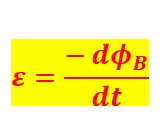What is Lenz’s Law?
Lenz’s law of electromagnetic induction explains that the direction of the current induced in a conductor by a changing magnetic field (as per Faraday’s law of electromagnetic induction) is such that the magnetic field created by the induced current opposes the changing magnetic field that caused it. The direction of the current flow is shown by Fleming’s right-hand rule.
Lenz’s law is based on Faraday’s law of induction, which says that a changing magnetic field will cause a current in a conductor. Lenz’s law explains that the direction of the induced current, which is opposite to the changing magnetic field that caused it. So, this is shown by the negative sign in the formula for Faraday’s law.

Where,
døB – Change in Magnetic field and
dt – Change in time
The strength of the magnetic field can be changed, or the magnet can be moved toward or away from the coil, or the coil can be moved into or out of the magnetic field.

Lenz Law Formula:
According to Lenz’s law, an induced current with a magnetic field that is perpendicular to the changing magnetic field that produced it is created whenever an electromagnetic field is induced by a change in magnetic flux.
The following is the equation for Lenz’s law:

Where,
N – Numbers of turns in the coil
What is the most significant contribution that Lenz’s law applies?
Lenz’s law is applied in order to determine the direction in which the induced current flows.
Why is the Lenz’s law often referred to as the law of the conservation of energy?
Lenz’s law is based on the principle of the law of the conservation of energy. It demonstrates that the mechanical energy is spent in the process of doing work against the opposing force encountered by the moving magnet, and the energy is then converted into the electrical energy that causes current to flow in the solenoid as a response.
Lenz’s law applications:
1. Electromagnetic brakes and induction cooktops are two examples of applications for Lenz’s law.
2. Balances using eddy current technology
3. It is also used for electric generators, specifically alternating current generators.
4. Metal detectors
5. Dynamometers that use eddy currents
6. Stopping mechanisms for the train
7. Card Readers and Scanners
8. Electronic microphones










